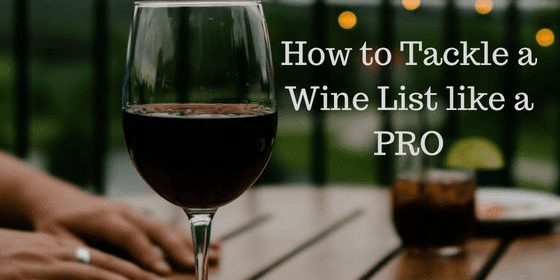Tackle a Wine List Like a PRO.
For many of us, the second a wine list is placed in our hands at a restaurant, we begin to panic. Ordering wine at a restaurant piles on the pressure. Will everyone at the table like our selection? How does retail pricing measure up to restaurant fees? Can the somm tell I don’t really know how to pronounce Gewürtztraminer?
It doesn’t have to be this way. With a few insider tips from the sommelier’s side of the coin, you’ll be ready to tackle the wine list like a pro.
While it may feel like the server is silently mandating you to order wine immediately upon sitting down, shrug that feeling off and take your time to decide. If you’re up for it, order a cocktail or glass of bubbly to start off the meal, and make your leisurely perusal of the list even more enjoyable.
And don’t forget the golden rule: Never hesitate to ask a server, sommelier, or manager questions about the by-the-glass or by-the-bottle list. Not only are you more likely to get a wine you’ll love, but this allows the hospitality professionals a chance to connect with you. It’s likely that you’ll get even more attentive service throughout the meal.
Keep these five tips in mind at restaurants and you’ll never feel flummoxed by a wine list again.
LOOK FOR ODDBALL GRAPES OR REGIONS ON THE BY-THE-GLASS LIST.
By-the-glass (BTG) wines are huge revenue drivers in a restaurant. They see a higher markup than by-the-bottle wines, have less waste than draft beers, and offer more precise cost calculations than cocktails or food. Sommeliers know that guests flock toward familiar grapes like Sauvignon Blanc and Pinot Noir, so if a somm includes an oddball grape or region on the BTG list, chances are he or she particularly loves it.
In fact, it makes more sense for a beverage director to list familiar grapes among the pricier BTG options, so oddball grapes like Furmint or Schiava typically offer better bang for your buck. Don’t hesitate to ask about the offbeat selections and request a taste before committing to a full glass.
ARE YOU AND YOUR DATE ORDERING THE SAME GLASS OF WINE? GET A BOTTLE.
Let’s talk a little bit about wine pricing. Glasses of wine typically have a markup of four times the wholesale cost. Put another way, the price per glass is often the amount that the restaurant paid for the bottle. That markup structure usually holds true for a bottle, which will be listed on your menu at four times the price the restaurant paid for it.
Most BTG pours are are five ounces, sometimes six, meaning that there are typically five glasses in each 750 milliliter (or 25-ounce) bottle.
What do all of those numbers mean? Essentially, if you and your date are ordering the same glass of wine, it’s more cost effective to get a bottle. The chances are good that you’ll each have more than one glass — you might even finish the first glass before your food arrives — which means you’ll be paying for four glasses total. Since a bottle costs the equivalent of four glasses but actually contains five glasses, it’s a no-brainer.
IN FACT, MAYBE DON’T LOOK AT THE BTG LIST AT ALL.
Opting for a bottle of BTG wine might get you an extra glass for your money, but if you’re thinking of sharing a bottle, you might want to steer clear of the BTG list altogether. Whereas glasses of wine and their respective bottles are priced at a 4-times markup, the by-the-bottle list tends to hover around a 2.5-to-3- times markup. Cheaper bottles typically have a higher markup, while more expensive bottles have a lower markup; while it may feel intimidating, it’s worthwhile to crack open the big list and get more value for your money.
SHARE YOUR BUDGET LOUD AND PROUD.
Flipping through pages of regions, producers, and vintages can seem futile without a plan or guidance, which is why it’s always worth asking for advice. Share the kinds of wine that you enjoy with a sommelier or server, describing whether you’re in the mood for something light or full, fruity or earthy, etc.
Don’t shy away from the most important consideration of all: the price tag. Confidently state your budget or ideal price range, and the sommelier will point out a few different options for you. At many restaurants $60 is a sweet spot. It typically gets you a range of style options without spending an arm and a leg. If a restaurant only has one or two options under this price point, it isn’t a well-rounded wine list.
Worried about seeming cheap? Don’t be. The best wine lists have several options at value price points, and a good sommelier or server will point out the differences between them rather than shaming or up-selling you. Two $45 bottles could taste very different, so you want to be sure you get what you want.
YOUR WINE PREFERENCES MATTER MORE THAN FOOD PAIRING.
When food is thrown into the mix, most assume that the wine equation is infinitely more difficult to solve. The “rules” say that white wine goes with fish and red wine goes with steak, but I’m ordering surf-and-turf — help! Wine and food do affect each other, of course, but your wine preferences dictate your enjoyment of the pairing much more than the menu does.
If you order a dry-aged steak but despise everything other than white wine, the tannic red that would classically pair with that dish will probably not win you over. (That doesn’t mean that an insistent sommelier won’t try to change your preferences, though.) And if you’re an adventurous drinker but have ordered many different dishes, don’t worry about finding the perfect pairing for each and every course. Look for wines that have balance and acidity, which will be versatile across many types of foods.
Credit to:








